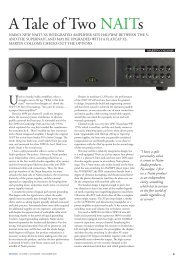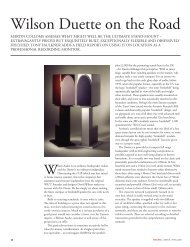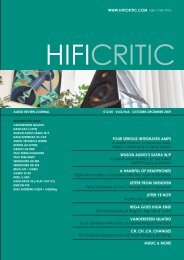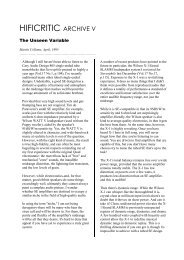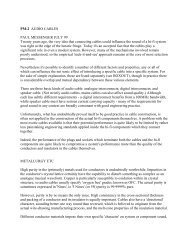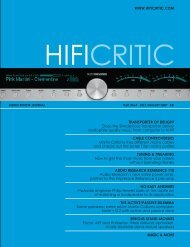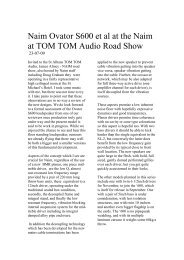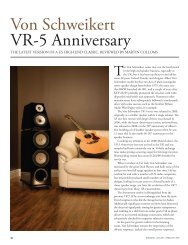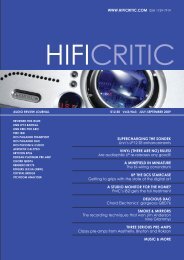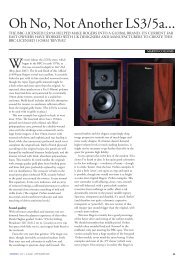Download - Hificritic.com
Download - Hificritic.com
Download - Hificritic.com
Create successful ePaper yourself
Turn your PDF publications into a flip-book with our unique Google optimized e-Paper software.
23 rd UK AES conference 9,10 April 2008:<br />
‘Music Everywhere’<br />
New Hall College, Cambridge<br />
You never know what to expect from these<br />
conferences for stereo audio but Editor Paul Messenger<br />
and I both attended and found much of interest. It was<br />
a beautiful spring morning before the conference<br />
opened, Kings College looked particularly fine.<br />
-----------------------------------------------------------------------------------------------------------<br />
There was clear and present confirmation of the ongoing revolution in the delivery of<br />
music to listeners, one which is challenging sectors of the music retail and Hi Fi<br />
<strong>com</strong>ponent business. While the rumours of the death of CD have been much exaggerated,<br />
there is no doubt that the CD singles market is now dominated by download and by the<br />
acknowledged market leader iTunes. In fact for both single and music sales as a whole
iTunes dominates making it harder for retails chains to make necessary returns on<br />
physically packaged audio, and while DVDs have been something of a lifesaver, this too<br />
is rapidly expanding in the download scene, taking sales from high street stores.<br />
The huge catalogue of CDs, new and second hand will persist for decades but the new<br />
business is elsewhere. It is unlikely that the high quality audio potential inherent in<br />
Blu-ray will be significantly realised owing to the high costs of mastering, including the<br />
royalty issues. In addition this remains a physical media and object to be made and<br />
stocked and stored, and for such things, their days are numbered. Blu-ray is now not<br />
expected to <strong>com</strong>e close to the historic market penetration of DVD, even after a future<br />
decade of sales.<br />
It is not news to relate that downloads are moving from the stage where we and our like<br />
took a snooty attitude to what was available, 128k MP3 and similar lossy <strong>com</strong>pressed<br />
material, judging it unsuitable for high fidelity reproduction. Data rates are improving,<br />
storage is rapidly be<strong>com</strong>ing cheaper and cheaper and there is no longer any disincentive<br />
to get high quality music, via purchase of course.<br />
At last the audio business is waking up to the idea that music will no longer be only<br />
physical discs on a shelf but may be present in a number of locations including streaming<br />
net access, but also on a enthusiast’s <strong>com</strong>puter, media server, on one or more iPods or<br />
similar portable devices, and additionally dedicated Hi Fi storage devices which are<br />
rapidly moving from networked <strong>com</strong>puters sporting Windows Media Player to custom<br />
designed unitary ‘ audio drives’ with audiophile output potential. Such are exemplified<br />
by the new Naim HDX.<br />
……………………………………………………………..<br />
John Bird of Understanding and Solutions gave the Keynote Address, aptly tilted<br />
‘What is Happening to the Global Hi Fi Industry?’ Packed with facts and figures, some<br />
aspects I felt relevant included his view that the long term trend decline in the sales of<br />
stereo separates had at last <strong>com</strong>e to and end and that now a small but continuing growth<br />
was to be expected.<br />
It seems that the continuing meteoric growth in portable music players has produced<br />
fallout of more discerning quality conscious customers who see separates as the means to<br />
improve the performance of the investments in their player hardware, and not least the<br />
music loaded into them. Such development is also fuelling the growth of still better<br />
loudspeaker docks where the demand for still more power and higher quality is evident<br />
and could be supplied in part by well known audio brands. We have already seen<br />
evidence of this activity with product from Monitor Audio, Meridian, B&W, T&A, and<br />
not least Bose.<br />
John explained that for consumer electronics spending the ‘Home Audio’ market had<br />
fallen from 15% of the total in ’88 to just 6% by 2007. St the same time the whole CE,<br />
Consumer Electronics market had doubled from Euro 33bn to 66bn, not accounting for<br />
inflation.<br />
‘Audio’ has transformed into ‘A/V’ over this period, of which ‘loudspeakers and<br />
separates’ are only 22% of the total, and with DVD players dominating by value with
24%. For the US the audio separates market has remained steady at $1.5bn,on trade<br />
values. The MP3 and equivalent player world market reveals some extraordinary figures.<br />
From 3 million shipped in 2002, it grew 200%, 240%, 165 % and 34% in successive<br />
years with another 18% growth expected for 2007 to perhaps 120 million players sold in<br />
that year!<br />
Money spent globally on music is stable at around $37bn annually but the packaged<br />
physical entity, CDs peaking at $34bn in 2004, is expected to decline to half by 2011.<br />
This shortfall will be replaced by download to mobile telephone, and the internet delivery<br />
respectively.<br />
Apple increasingly dominates both the hardware and software to the detriment of<br />
traditional audio brands, eg Sony, JVC, Panasonic, Hitachi and the like. Digital music is<br />
powerfully driving innovation and product design for example for music servers and<br />
related audio drives.<br />
Perhaps unexpectedly, video games of increasing quality are pushing demand for better<br />
sub woofers and accessory speakers to improve the Hi Fi experience beyond that possible<br />
from a console television with its impossibly small speakers, these emasculated in the<br />
name of styling.<br />
………………………………………………………………………………<br />
Several conference speakers provide fascinating background on a range of pro audio<br />
issues, for example using the IP network for broadcast applications, e.g. linking studios<br />
and radio transmitters, and safeguarding the performance and quality of the network<br />
connection for higher rate streamed media traffic.<br />
Steven Harris of BridgeCo AG specialised on the subject of home networking,<br />
premium audio services, including databases, fir example to help you find what you want<br />
to listen to. This aspect is now considered vital to a <strong>com</strong>petent offering. Much of this<br />
relies on interfacing where the chips ( e.g. the DM 850 media networking processor) and<br />
related software take care of the <strong>com</strong>munication access and format issues making<br />
operation simple and transparent. UPnP has be<strong>com</strong>e the key feature (universal plug and<br />
play). With 40 million iPods sold in the US alone, replay of ’pod content has be<strong>com</strong>e<br />
mandatory for home audio systems, and more recently access to the digital data is often<br />
provided via the USB interface and not the more <strong>com</strong>mon headphone and line output<br />
terminals. In the US the subscription model for music delivery is strong with many<br />
providing lossless content including Music Giants, the Onkyo Music Library, Linn<br />
Online, iTracks, and Chesky.<br />
www.bridgeco.<strong>com</strong>
BridgeCo Networked Audio Adapter<br />
……………………………..<br />
Mike Smyth, pronounced ‘Smith’, of Smyth Research, gave a talk on a virtualisation<br />
algorithm dubbed SVS, which looked intriguing, and unquestionably had a stunning<br />
auditory impact when auditioned. I think that it has relevance to home stereo and I will<br />
try to briefly explain what it is and what it is for. Initially the algorithm forms the heart<br />
of a portable studio monitoring system including for multiple channel surround sound.<br />
The ‘monitoring system’ may nevertheless be packed in a bag or two, and <strong>com</strong>prises a<br />
clever box incorporating the vital algorithm and a pair of top quality, open backed Stax<br />
electrostatic headphones.<br />
We have all played with binaural for years and then the industry has gone farther with<br />
more sophisticated HRTF syntheses, leading to higher performance spatialisers both for<br />
loudspeaker stereo and for headphone reproduction. For Smyth, the objective is not<br />
simply clever tricks, but to try to replicate the ‘sound’ of a full free space loudspeaker<br />
monitoring system in its natural studio environment yet reproduced on portable<br />
headphones. It is done by placing the engineer in the chosen environment and permitting<br />
ten or so minutes of precision HRTF measurement including the use of point<br />
microphones placed at the subject’s ear canal entrance. The SVS algorithm is created<br />
from the acoustic measurements.<br />
In operation in<strong>com</strong>ing stereo and multi channel audio signal is <strong>com</strong>puted, convolved<br />
with the SVS algorithm to create a two channel signal to the headphones, this the<br />
<strong>com</strong>plex sound pressure field which would have arriving at the listeners’ ears if he or<br />
she were present in the original sound field. In theory the listener then hears the raw<br />
music tracks, via the mix down process for which there is also a local mixer, e.g. Sonic<br />
Solutions or whatever, and the sound of the aimed for mix down in a real studio is<br />
virtualised, recreated for the user. One of the primary features considered important for<br />
maintaining a sense of reality is to somehow master the movement of the sound field<br />
such that when the monitoring engineer moves his head the orchestra does not follow<br />
round unnaturally like a dizzy carousel, as it usually does. Thus a head movement tracker<br />
is included and as you move your head to face a virtual source that source remains<br />
naturally fixed in position, and moreover the sound character of the virtual source is
automatically corrected for the head angle concerned. This has to be done in real time and<br />
is seamless.<br />
The Cambridge demonstrations involved direct <strong>com</strong>parison of the generated surround<br />
sound field heard via headphones with a test 5.1 monitoring system built from the larger<br />
and high quality KEF Reference 200 series loudspeakers.<br />
Even though I had not had my own HRTF uniquely calibrated for this session, which can<br />
add considerably to the sense of realism, my impression of sound field reality was so<br />
convincing that initially I was sure that the headphone simulation was in fact inoperative<br />
and that I was still listening to the real speaker system audible through the largely<br />
acoustically transparent open back electrostatic headphones.<br />
But taking off the headphones resulted in the effect of the whole one ton virtual sound<br />
system <strong>com</strong>ing off with them and thus the merit of the technique was well proven.<br />
I made further more careful <strong>com</strong>parisons, A/B ing the real and virtual systems at will and<br />
found the fidelity of the headphone driven system to be high, showing the faults as well<br />
as the virtues of the prime replay system. In this it was substantially faithful to the<br />
physical sources, foibles and all. In particular that crucial test of virtualisation, namely<br />
the sense of stability and presence for the wholly virtual centre channel was passed with<br />
flying colours. By definition it cannot improve on the reality originally present. But of<br />
course that is the whole point. By so doing the monitoring system for which the engineer<br />
is wholly familiar, is the one he or she can take on location.
Steve Harris of AudioPlus experiencing the SVS 5.1 simulation<br />
So for home stereo, and not excluding home theatre, you have the possibility of encoding<br />
your system to the virtualiser and then listening at virtually any volume, perhaps late at<br />
night, to the experience of your system and room operating ‘live’, this while on<br />
headphones.<br />
For HT the whole surround experience, save body pressure response to low bass (for<br />
which there is a vibration simulator) , is also provided while several listeners with several<br />
headphones may share the optimum experience; each is allowed to experience the ideal<br />
‘sweet spot for surround sound balance and focus.<br />
But there is yet another seductive possibility. Since the system is essentially self<br />
calibrating, an enthusiast could visit, with the box of tricks, other high end audio and<br />
home theatre systems and have those encoded and memorised, ready to be experienced<br />
for years afterwards and with any music you choose.<br />
The gulf between stereo on headphones, pleasant but manifestly an auditory <strong>com</strong>promise,<br />
and the spatially <strong>com</strong>pletely convincing surround reproduced by SVS, with full out of<br />
head localisation, multiple spaced sound sources, image depth and focus, has to be heard<br />
to be believed. The technique will presently cover 7.1 while full three-dimensional
simulation is already possible using a synchronised pair of processors. I cannot wait too<br />
hear a fully immersive sound field reproduced this way.<br />
This product will remain in the PRO domain for probably this year while they gain<br />
production experience before moving on to a domestic HI FI version. We hope to review<br />
the system concept later this year.<br />
…………………………………………………..<br />
Another interesting lecture, which was matched by a fine demonstration, was by Chris<br />
Kyriakakis of Immersive Audio Laboratory and Sunil Bharitkar of Audyssey<br />
Laboratories.<br />
Audessy DSP loudspeaker correction technology has been making great progress in<br />
recent years and has be<strong>com</strong>e an almost standard feature in many Home Theatre receivers<br />
even the least expensive. In contrast to the high resolution ‘fix every glitch’ approach<br />
which introduced the DSP technique to the loudspeaker world, Audyssey have long<br />
been aware that such perfectionist correction makes ill judged demands on the<br />
amplification while dismally failing to correct for other listener speaker locations. For<br />
me a key feature is their use of correction in both frequency and time domains, which I<br />
think greatly improves the naturalness of the correction especially I respect of the driven<br />
room acoustic.<br />
Continuing research is directed to improved statistical sampling of the acoustic drive<br />
from the speakers to the listening space together with the use of spatial weighting with<br />
pattern recognition to reduce the error function (response deviation) for a <strong>com</strong>bination of<br />
perceived response evenness and locations. Individual lower Q correction is applied to<br />
channels of the loudspeaker array, e.g. for Home theatre, both for individual speakers and<br />
in respect of the overall summed acoustic.
The beneficial result of such correction was shown graphically and by demonstration.<br />
In addition we were shown a more advanced development designed to help scale the<br />
movie soundtrack, which has been optimised for cinema reproduction, to the reduced<br />
dynamic headroom and lower sound pressure levels available in the home. This employs<br />
dynamic adaptation and dynamic, sound level referenced, advanced loudness correction.<br />
You might be forgiven for doubting the efficacy of such <strong>com</strong>plex frequency and<br />
amplitude processing but the results spoke for themselves, increasing realism while<br />
maintaining the information content and avoiding system overload. Improved HT sound<br />
reproduction in the home is clearly on the cards though I do not see it directly applicable<br />
to audiophile stereo.<br />
Audyssey dynamic loudness <strong>com</strong>pensation tracks perceived frequency response with<br />
volume from a calibrated in-situ sound level reference. The red trace shows the<br />
subjective effect of omitting the <strong>com</strong>pensation<br />
……………………………………………………….<br />
Improbable perhaps, but viable through development, Oliver Haffenden and Andrew<br />
Murphy of BBC Research gave a presentation on DRM, no, not Digital Rights<br />
Management , but Digital Radio Mondiale, a way to put mono and even stereo, wide<br />
bandwidth digital audio onto the Long, Medium and Short Wave bands and they<br />
included data from a recent working trial with Radio Devon. Long distance propagation<br />
was also covered together with new techniques for expanded country coverage using<br />
ionospheric scatter, more correctly skywave reflection, NVIS.<br />
While the data rate is low, under fair to good condition MPEG AAC coding can be used<br />
and while not of full FM quality it is not too distant from DAB and is much better than<br />
noisy and fading medium and long wave reception for very many distant listeners. It also
provides a means for transmitting enriched material, graphics, breaking news, programme<br />
data etc, a much enhanced RDS if you like. This could be very valuable in out of the way<br />
remote regions of the world.<br />
…………………………………………………………<br />
Simon Mason of Mobile Media ‘got under the bonnet’ for DAB, nicely illuminating<br />
the subject. For me he also explained why the sound quality would never quite satisfy<br />
audiophiles or match good reception FM stereo, an issue we reported on in the Arcam<br />
Solo review in Issue 1 Jan Feb 2007.<br />
It is because the DAB international standard was defined in the late 1980’s when the only<br />
viable data reduced coding was MPEG 1 Layer 2. While AAC and better ‘layers’ have<br />
since be<strong>com</strong>e available, existing receivers and infrastructure must be kept working and<br />
we are stuck with it, said to be good enough for 95% or customers, and providing a much<br />
improved radio service for more difficult reception areas, never mind those additional<br />
stations which simply cannot be fitted into existing bands. DAB allows listeners to access<br />
these services.<br />
It is easy to see now that it could have been designed so that software driven upgrades to<br />
receiver codecs could be have been upgraded, over the air, almost as the customer sleeps,<br />
but when DAB began the hardware was much more difficult to execute and thus the<br />
decode instructions are permanently written into the receiver chips.<br />
………………………………………..<br />
Another ‘radio’ lecture was given by Nick Sharwood-Smith of Wave Science<br />
Technology, London. Here the subject of broadcast programme delivery is the internet.<br />
Entitled Lighthouses, Pilots and Bitrates Riding the Waves of Internet Radio and<br />
concerned live streaming, not downloading or Podcasts. With up to 10,000 internet radio<br />
stations, some do have better quality and even good quality stereo. There is no reason<br />
why using broadband FLAC material at top quality, lossless 900kbps material cannot be<br />
provided for live internet broadcast. Issues of coder in<strong>com</strong>patibility will need to<br />
addressed, once again the issue of interoperability is paramount for the future.<br />
…………………………………………….<br />
Tim Nind of Harman/Becker briefed us on the more sophisticated design aspects of<br />
modern car audio, now embracing 5.1 replay and additionally 7.1 via the Windows Media<br />
Player version of Logic 7. An interesting point was the observation that the differencing<br />
L-R signal used in Logic 7 synthesis was not effective on MP3 lossy <strong>com</strong>pressed<br />
material. This suggests that it could be a useful test for assessing relative impairment of<br />
coders in this respect. Loss of quality for this difference channel has not been a coder<br />
design issue far.<br />
He examined that prototype vehicles are no longer made to provide a platform for in-car<br />
audio development and full modelling of the interior is now done to predict the<br />
performance in concert with the proposed sound systems. The resulting synthesis is fully
‘fluid coupled’ and has specifically led to many improvements, for example resulting in<br />
the ultra <strong>com</strong>pact under-seat subwoofers now standard in BMW vehicles. Two channel<br />
audio has now moved on to a full AVR platform with a range of media material and<br />
formats accepted. This can provide more stable localisation over the vehicle environment.<br />
Full DSP allows for precise correction for local acoustics and good voicing of the entire<br />
vehicle. The 5 Series BMW demonstrator provided at Cambridge played stereo material<br />
at a standard as close to genuine Hi FI as I have heard to date, with very little coloration<br />
signature of the vehicle remaining. It sounds dynamic and neutral, highly detailed, with<br />
deep crisp bass, though the vehicle was static which always helps. This was prepared and<br />
demonstrated by Arndt Hensgens .Thanks also to both the human demonstrators in the<br />
Beemer and the Range Rover, by Harman/Becker.<br />
……………………………………..<br />
E R Toulsen , rob.toulsen@anglia.ac.uk, looked at the wider participation in music and<br />
music production, citing some surprising statistics. For example US guitar sales for 2006<br />
were 260% greater than 1998at a massive 3 million, aided no doubt by a continuing fall<br />
in numeric price, despite inflation. Thus many more people have access to guitars and<br />
this reflects increasing participation in music making. Likewise music production and<br />
recording has be<strong>com</strong>e inexpensive via low cost <strong>com</strong>puters and for that matter the digital<br />
mixer software and hardware. US retail sales of soundcards and related software has gone<br />
from $170m for 2000 to $411m for 2006. (How we could wish for such growth in stereo<br />
separates!)<br />
Rob discussed the issues confronting inexperienced users of such versatile and <strong>com</strong>plex<br />
systems, the need to be able to identify exceptional talent from the main herd and how to<br />
get nearer to a <strong>com</strong>mon standard for production quality. Education is an answer with the<br />
development of courses which can help teach the skills required.<br />
……………………………………..<br />
Former Corporate Vice President of the Consumer Media Technology Group at<br />
Microsoft, Amir Majidimehr ( amirm@amir-views.<strong>com</strong> ) gave the second Keynote<br />
Address envisioning future media content, its purchase and supply, and how it may be<br />
accessed in the car, via a mobile and in the home. It was an exciting and almost<br />
breathless rapid fire delivery, a torrent which was punctuated by many eddies <strong>com</strong>prising<br />
related stories, facts and anecdotes. I could not even attempt to summarise this content<br />
but here are a few highlights. And I hope that I have got the gist.<br />
Much of the content had been made public but was delivered in a way which made sense<br />
of the whole and <strong>com</strong>municated the speed and excitement of growth and technical<br />
development in the field.<br />
Music is unquestionably the most popular media type, and its availability and delivery<br />
has undergone an incredible transformation, clearly wrong footing the major music<br />
labels.<br />
Digital audio started with CD, non-encrypted, this was perhaps unintended, and yet for<br />
most users is its best feature. You can rip it to your <strong>com</strong>puter and play it on MP3 and
many other music replay devices. But it led to the unplanned revolution of rampant<br />
piracy. Peer to peer copying is illegal yet everyone and their children do it.<br />
Stores cope with perhaps 5 % theft, Microsoft 40 to 50 % at which point the <strong>com</strong>pany<br />
has to tighten the ‘squeeze’ a bit, but 9 in10 recorded music tracks are ‘stolen’. How is<br />
the music business to make a living? Who will pay the performers and studio personnel?<br />
Managing delivery of music for the future may be beyond established models, it will<br />
need advanced software to keep track of it all.<br />
Is MP3 and the like the end of Hi Fi? Those lossy perceptual coders necessarily had had<br />
non linear artefacts which were intended to elude audiophiles. The public generally did<br />
not learn to hear the coding artefacts. But now we have a choice. We can download at<br />
higher bit rates, and even pay for good quality material; this enabled by versatile replay<br />
media software such a Windows Media Player, WMP. Quality subscription libraries are<br />
DRM protected, for many suppliers, when you stop paying, your downloads expire. Now<br />
valueless, you either re-subscribe or delete them from your hard drive.<br />
CD may have been expensive when it began but it essentially they have not increased in<br />
price and the in<strong>com</strong>e has declined. With iTunes at 99 cents a track, $10 a CD, where is<br />
the margin for iTunes and the Music House when transaction costs are accounted for?<br />
The truth is that iTunes does not really make money and the record <strong>com</strong>pany does not<br />
really get enough to finance new catalogue. The music is sold at slightly over cost. The<br />
larger Music Labels are in decline from their 1999 peak and nothing can save them, the<br />
model is simply wrong for post 2005. Independent labels will gain, with leaner<br />
operations, and of course internet involvement. Unbelievably 80% of all music bought in<br />
the US is now via iTunes, now the dominant music retailer. Potentially there are 80<br />
million tracks available for download. It is suggested that this huge music resource it will<br />
be mainly free of copy code, on open format, and they and their ilk but will have invisible<br />
watermarks to provide a degree of monitoring of peer to peer activity, to track ‘leakage’<br />
Apple operates on the <strong>com</strong>puter marketing model and makes its profit on the hardware, in<br />
this namely selling iPods at an amazingly high trade margin of 55 points. The product is<br />
such demand that such <strong>com</strong>mercial policy is actually practicable.<br />
DVDA and SACD tried to pitch quality against convenience and failed. Blu-ray has<br />
much superior audio interactivity but is fully protected and cannot be ripped; most<br />
consumers would find this pretty useless since music purchased could not be copied to or<br />
played on anything else. The continuing existence of DVD will prevent Blu-ray video<br />
reaching a large market as it is simply too good, with $25 DVD players barely costing<br />
more than the carton and printed instruction manual! Yet the screen images are good<br />
quality and the sound isn’t bad either.<br />
(I hope this recorded talk will be officially released on the AES UK website)<br />
……………………………………………..
Richard Elen of Brideswell Associates (former Editor of Studio Sound)<br />
explained the virtual world of Second Life, a ‘Metaverse’ with several million<br />
inhabitants. Clubbing happens here amongst other activities and Richard has looked into<br />
the music production and distribution chain within Second Life showing how to<br />
maximise audio quality and effectiveness in this virtual environment. The operating<br />
system for ‘Radio Riel’, working in to the Second Life network, was spelled out with<br />
helpful advice as how to maintain reasonable quality and thus actually entertain rather<br />
than just amuse the participants.<br />
Many thanks to the AES UK Committee for facilitating our attendance.<br />
www.aes.org/sections/uk




